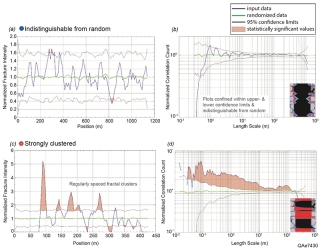The Role of Chemistry in Fracture Pattern Development and Opportunities to Advance Interpretations of Geological Materials

S.E. Laubach, R.H Lander, L.J. Criscenti, L.M. Anovitz, J.L. Urai, R.M. Pollyea, J.N. Hooker, W. Narr, M.A. Evans, S.N. Kerisit, J.E. Olson, T. Dewers, D. Fisher, R. Bodnar, B. Evans, P. Dove, L.M. Bonnell, M.P. Marder, L. Pyrak-Nolte
Reviews of Geophysics, 2019, https://doi.org/10.1029/2019RG000671
Study Summary
Fracture patterns in rock strongly affect directions, magnitudes, and heterogeneities of both fluid flow and rock strength. Accurate and testable predictions of patterns are essential for understanding many societally important processes in the Earth and for effectively managing subsurface engineering operations. Chemical processes play a larger role in opening-mode fracture-pattern development than has hitherto been appreciated. For fractures formed at depths of ca.1-10 km and temperatures of 50-200℃, new evidence shows chemical reactions are common and more diverse than previously recognized. We describe how viewing fracture formation and evolution from a chemical perspective helps to solve problems in fracture-pattern analysis. We outline the main impediments to subsurface fracture-pattern measurement and interpretation, assess implications of recent discoveries in fracture history reconstruction for process-based models of fracture and cement accumulation, review models of fracture cementation and chemically assisted fracture growth, and discuss promising paths for future work. Potential exists for basic scientific investigations to lead to progress on what has been one of the most refractory practical problems in subsurface science. Results suggest that progress in fracture interpretation and prediction can be made using observational, experimental, modeling, and theoretical approaches that view fracture patterns as the result of coupled mechanical and chemical processes. The diagram shows how differences in fracture cement accumulation can correlate with contrasts in key fracture pattern attributes, in this example, fracture clustering.
Why is this research important and why do the results matter?
- A chemical perspective helps solve challenges to understanding subsurface fractures: inadequate samples, ambiguous analogs, difficulties determining which models are correct from observations
- Many tools of chemical analysis, experiment, modeling and theory have yet to be brought to bear on understanding how fracture patterns develop at geological time scales
- Chemical and mechanical investigations together have great potential to solve challenging practical problems in subsurface science
Additional Information
https://agupubs.onlinelibrary.wiley.com/doi/abs/10.1029/2019RG000671